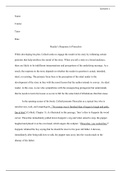Essay
Reader’s Response to Pinocchio
- Course
- BUS/MKTG (ENG212)
- Institution
- Thompson River University (TRU )
While developing his plot, Collodi seeks to engage the reader in his story by inflaming certain passions that help reinforce the moral of the story. When you tell a story to a broad audience, there are likely to be indifferent interpretations and perceptions of the underlying message. As a result, ...
[Show more]



